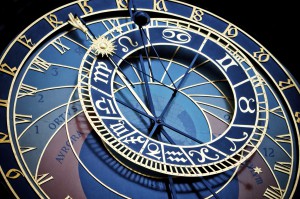Astronomical Clock (Orloj)
By Erin Naillon
 Old Town Hall Tower
Old Town Hall Tower
Prague’s astronomical clock is one of the most popular draws in the city. Enthusiastic, clapping tourists crowd in front of the Old Town Hall tower to watch the clock strike the time every hour. As the bells chime, two doors above the clock face slide open and statues on a rotating platform move into view, one after another. These figures represent the Apostles.
Figures on the Astronomical Clock
Other figures, on each side of the clock face, also move. These figures also show the prevailing prejudices of the time in which they were made. Going from left to right, the first figure is Vanity. This is the figure of a man admiring his reflection in a hand mirror. The next figure is a Jew with a bag of money, representing Greed. Death, represented by a skeleton, beats a drum and nods its skull. A Turk is the Infidel rounding out the set. Four other figures remain motionless – The Astronomer, Chronicler, Philosopher, and Angel.
 History and Legends
History and Legends
The astronomical clock has performed its work, off and on, for 600 years. It is the only astronomical clock still in operation. This impressive piece of Czech (and mechanical) history was created in 1410 by two men: Mikuláš of Kadaň and Jan Šindel. An erroneous report lists a certain Master Hanuš as the maker of the clock, adding an intriguing legend. According to this legend, Hanuš had his eyes put out by the King himself so that he couldn’t make another impressive clock for anyone else. Hanuš got his revenge by making his way to the clock tower and throwing himself into the works, achieving the dual purpose of killing himself and stopping the clock, which then failed to work for many years. Eventually, a skilled artisan was able to start it again. There is no truth behind the story, but it is true that the clock has stopped many times in its existence.
Changes over the centuries
During the Prague Uprising in May of 1945, the Nazis damaged the clock severely with anti-aircraft guns; the clock lay still for the next three years. The astronomical clock has seen many changes over the centuries. In 1490, some additions were made, including sculptures and the calendar dial. The moving statues date from the 17th century, and the Apostle figures from 1865. Artist Josef Mánes repainted the calendar dial that same year.
The Old Czech time
The entire appearance of the astronomical clock helps to make it unique. The inner ring of the clock face shows the symbols of the zodiac. The outer ring is numbered in Roman numerals, from 1 to 24, to show the time. On the very edge of this ring, Schwabacher numerals indicate Old Czech time. A figure shaped like a sun, attached to a golden arm, moves around the zodiacal circle. A moon icon is also found here.
600th anniversary of the astronomical clock’s existence
October 9, 2010, saw celebrations of the 600th anniversary of the astronomical clock’s existence.
The astronomical clock plays daily to appreciative, cheering audiences. As the last chime fades, a trumpeter in the tower, wearing a yellow-and-red uniform, plays a short tune to the crowd below, waving to them after his performance. He plays on each side of the tower, applauded each time.




